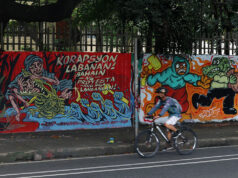Peso strengthens on BSP policy rates decision
The peso strengthened a tad against the dollar on Thursday, June 21, following the local central bank’s decision to raise its interest rates.
The peso closed Thursday’s session at P53.46 against the greenback, two centavos stronger than the P53.48-per-dollar finish on Wednesday.
The peso immediately traded stronger, opening the session at P53.39 per dollar. Its intraday high stood at P53.35 versus the US unit, while its worst showing was at P53.50.
Dollars traded soared to $860.95 million from the $650 million that switched hands the previous day.
A trader said that the peso traded the same as Wednesday as investors “bought heavily given the very strong dollar against most currencies.”
“However, we also saw heavy selling near P53.50, so the level of resistance was put on hold,” the trader said.
Ruben Carlo O. Asuncion, chief economist at UnionBank of the Philippines, said: “[The peso] was pretty strong throughout the day and this may be because of the rate hike.”
The Bangko Sentral ng Pilipinas raised its policy settings by another 25 basis points during their fourth review for the year. Rates now stand at a 3%-4% range.
The rate-setting Monetary Board decided to hike its benchmark rates as “inflation expectations remained elevated for 2018 and that the risk of possible second-round effects from ongoing price pressures argued for follow-through monetary policy action.”
“We’re also seeing more volatility in the exchange rate, which potentially adds to the dynamics on inflation that we need to be careful about,” BSP Governor Nestor A. Espenilla, Jr. said following the policy meeting.
“But trade spat uncertainties remain and Asian markets are bearing the brunt including the currencies,” Mr. Asuncion noted.
Since last week, the United States and China has been exchanging threats on slapping tariffs in its imports, sparking concerns of a looming trade war.
On the other hand, Michael L. Ricafort, head of the Economics and Industry Research Division of Rizal Commercial Banking Corp., said the peso hit its intraday high after the Philippine Stock Exchange index (PSEi) entered the bear market territory or at least a 20% slump from its peak.
The PSEi was down 2.2% on Thursday to close at 7,098.15, the lowest closing rate in nearly one-and-a-half years or since Jan. 5, 2017.
For Friday, the trader expects the peso to move between P53.30 and P53.50 against the dollar, while Mr. Asuncion gave a slightly wider range of P53.30-P53.60.
“The local currency might further strengthen [on Friday] on likely softer US initial jobless claims data, which is the leading indicator of U unemployment,” another trader said, expecting the peso to play between P53.35 and P53.50 against the US currency. — Karl Angelo N. Vidal



